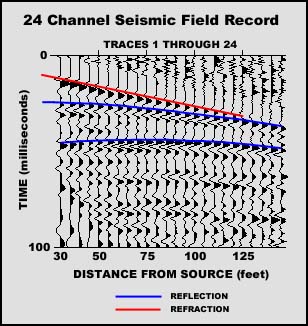








First
break: a term used
to describe the first "break" from background when recording seismic
waves. After the seismograph is triggered to record by the source, it
"listens" to the array of geophones. It records all incoming
signals during a set period of time usually on the order of hundreds of milliseconds.
Analysis of the recording shows that direct waves or refracted waves are the
first to appear in time on each trace of the record. By noting exactly
when in time these waves appear, or (as it is more commonly referred to) the
first breaks occur, and the distance from each geophone to the source, it is
possible to determine the velocities of the refracting layers.
Seismic refraction data can be interpreted in several ways. The simplest
approaches assume a series of plane, dipping layers. While effective in
many instances, this method is not suited to irregular or undulating layers.
The Generalized Reciprocal Method (GRM) goes beyond the plane-layer assumption,
producing a profile which allows for irregularities in the refracting surface.
Geosphere makes use of ViewSeis from
Viewlog Systems and SeisOpt from the University of Nevada to analyze
seismic refraction data. When possible, we combine GRM results with reflection
data to produce the most comprehensive seismic interpretation available.
12-Fold
CDP Stacked Seismic Reflection Profile showing
Dipping Layers and Faults
GRM
Seismic Refraction Line showing Depth to Bedrock and Associated Velocities.
Vertical Exaggeration is roughly 10:1.

email:
consultants@geosphereinc.com
124 north auburn road auburn, mi 48611 tel: (989) 662-6149
fax: (989) 662-7701
copyright ©1990-2007 geosphere inc
displayed
as a single seismic
cross-section. A seismic trace may contain from hundreds to thousands of individual
samples. With each shot generating 24 or 48 traces, a typical seismic
line will contain several million samples. Geosphere
processes these data with the "WinSeis Turbo" package, developed
by the Kansas Geological Survey for PC workstations. Augmented by several
programs developed by Geosphere,
we now have a seismic reflection processing system tailored to the unique
problems
encountered in high-resolution seismic work.
24-Channel
Seismic Field Record showing
many Coherent Events
A
seismic reflection section is, in principle, a series of seismic traces recorded
by a geophone at the same location as the shot. Each trace must
be time-corrected to allow for the source-geophone offset, the correction
depending on the layer
velocities. If the correction is accurate, a given reflection is moved
up the trace to the position it would have were the source and receiver coincident.
Using the field procedure described previously, 12 individual traces sorted
from 24-channel data, of various source-receiver offsets, will have a common
midpoint. These
12 traces, after correction, are summed to produce one common depth point,
or 12-fold CDP trace. The resulting summed traces are then


![]()


